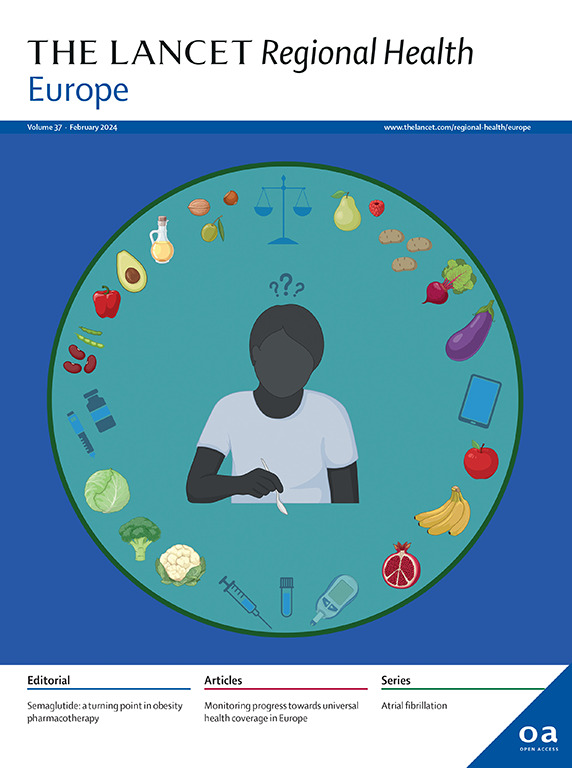Early and long-term effects of prophylactic and post-excision human papillomavirus vaccination on recurrent high-grade cervical intraepithelial neoplasia relative to margin status: a retrospective cohort study in the Czech Republic
IF 13.6
Q1 HEALTH CARE SCIENCES & SERVICES
引用次数: 0
Abstract
Background
The effect of human papillomavirus (HPV) vaccination on cervical intraepithelial neoplasia grade 2 or worse (CIN2+) recurrence with respect to cone margin positivity is unknown. Most studies assessed this effect beyond two months post-conisation. We aimed to determine both the duration and early onset of effect in women who had been prophylactically vaccinated or vaccinated after conisation, considering cone margin status.
Methods
This cohort study used data from one of the central laboratories in the Czech Republic, covering approximately 33% of women undergoing national cervical cancer screening. It included women treated for CIN2+ between 2010 and 2024 who had received either prophylactic HPV vaccination (available through the national immunisation program since 2011) or post-conisation vaccination (recommended by the Czech Gynaecological and Obstetrical Society since 2008). The vaccination effect was estimated using the incidence rate ratio (IRR) from a Poisson regression model, calculated as 100 × (1–IRR).
Findings
Of the 10,054 women enrolled, 919 were vaccinated after conisation, 502 prophylactically, and 169 had undetermined timing of vaccination. Throughout the follow-up period, CIN2+ recurrence was observed in 513 unvaccinated women, with a rate of 14·61 per 1000 person-years (py), in 14 prophylactically vaccinated women, with a rate of 5·84 (54% reduction; 95% confidence interval [CI]: 22–73%), and in 15 women vaccinated post-excision, with a rate of 3·37 (74% reduction; 95% CI: 57–85%). The high recurrence rate of 58·59 per 1000 py within six months of conisation was reduced by 80% (95% CI: 19–95%) with prophylactic vaccination and by 89% (95% CI: 57–97%) with incomplete post-excision vaccination. Among a total of 1771 women with a positive cone margin, recurrence was identified in 272 of 1568 unvaccinated women, corresponding to a recurrence rate of 51·62 per 1000 py. A reduction was observed in 84 prophylactically vaccinated and in 119 women vaccinated post-excision, with only 6 recurrence cases documented in each group. This corresponded to recurrence rates of 14·94 (62% reduction; 95% CI: 14–83%) and 9·78 per 1000 py (79% reduction; 95% CI: 52–90%), respectively.
Interpretation
Regardless of timing, HPV vaccination has a beneficial long-term effect in lowering the risk of CIN2+ recurrence. Despite the greater reduction in relapse achieved by post-excision vaccination, the difference compared with the prophylactic one was not statistically significant. The most pronounced benefit was observed within the first six months post-conisation, particularly in women with a positive cone margin.
Funding
Cooperatio 31 fund, Health Sciences, Charles University, Prague, Czech Republic.
预防性和切除后接种人乳头瘤病毒疫苗对复发性高级别宫颈上皮内瘤变的早期和长期影响:捷克共和国的一项回顾性队列研究
背景:相对于宫颈锥缘阳性,人乳头瘤病毒(HPV)疫苗接种对宫颈上皮内瘤变2级或更严重(CIN2+)复发的影响尚不清楚。大多数研究对这种影响的评估超过了确诊后两个月。我们的目的是在考虑锥缘状态的情况下,确定预防性接种疫苗或锥缘后接种疫苗的妇女的持续时间和早期效果。该队列研究使用了捷克共和国一个中心实验室的数据,涵盖了大约33%的接受国家宫颈癌筛查的妇女。它包括2010年至2024年期间接受CIN2+治疗的妇女,她们接受了预防性HPV疫苗接种(自2011年以来通过国家免疫规划提供)或接种后HPV疫苗(自2008年以来由捷克妇产科学会推荐)。利用泊松回归模型的发病率比(IRR)估计疫苗接种效果,计算为100 × (1-IRR)。研究发现,在10054名妇女中,919名在接种后接种了疫苗,502名接种了预防性疫苗,169名接种时间未定。在整个随访期间,在513名未接种疫苗的妇女中观察到CIN2+复发,每1000人年(py)的发生率为14.61,在14名接种了预防疫苗的妇女中,发生率为5.84(减少54%;95%可信区间[CI]: 22-73%), 15名妇女在切除后接种疫苗,发病率为3.37(减少74%;95% ci: 57-85%)。术后6个月内的高复发率为58·59 / 1000 py,预防性疫苗接种可降低80% (95% CI: 19-95%),不完全手术后疫苗接种可降低89% (95% CI: 57-97%)。在总共1771名锥体边缘呈阳性的妇女中,1568名未接种疫苗的妇女中有272人发现复发,相当于每1000人复发率为51.62。84例预防性接种疫苗的妇女和119例术后接种疫苗的妇女观察到减少,每组只有6例复发病例记录。复发率为14.94(降低62%;95% CI: 14-83%)和9.78 / 1000 py(减少79%;95% CI: 52-90%)。解释:无论接种时间如何,HPV疫苗在降低CIN2+复发风险方面具有有益的长期效果。尽管手术后接种疫苗的复发率更低,但与预防性接种相比,差异无统计学意义。最明显的益处是在锥体切除后的前六个月内观察到的,特别是在锥体边缘呈阳性的女性中。资助合作31基金,健康科学,查尔斯大学,布拉格,捷克共和国。
本文章由计算机程序翻译,如有差异,请以英文原文为准。
求助全文
约1分钟内获得全文
求助全文
来源期刊

Lancet Regional Health-Europe
Multiple-
CiteScore
19.90
自引率
1.40%
发文量
260
审稿时长
9 weeks
期刊介绍:
The Lancet Regional Health – Europe, a gold open access journal, is part of The Lancet's global effort to promote healthcare quality and accessibility worldwide. It focuses on advancing clinical practice and health policy in the European region to enhance health outcomes. The journal publishes high-quality original research advocating changes in clinical practice and health policy. It also includes reviews, commentaries, and opinion pieces on regional health topics, such as infection and disease prevention, healthy aging, and reducing health disparities.
 求助内容:
求助内容: 应助结果提醒方式:
应助结果提醒方式:


